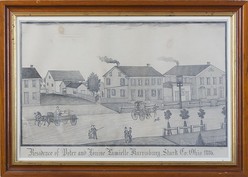 With the kids flitting around, I’ve been casting about for something creative and have found some satisfaction with photography. It’s convenient, it’s cheap, and unlike knitting a pattern, I can stop at just about any point if (when…) there’s a household crisis. One of the things that confounds me as a photographer (mostly, I realize, due to the limitations of the equipment I work with) and one of the same reasons we appreciate the photographers we do is the ability to capture what we see. How often have you looked at your beach sunrise pictures and thought, “It just doesn’t do it justice”?
With the kids flitting around, I’ve been casting about for something creative and have found some satisfaction with photography. It’s convenient, it’s cheap, and unlike knitting a pattern, I can stop at just about any point if (when…) there’s a household crisis. One of the things that confounds me as a photographer (mostly, I realize, due to the limitations of the equipment I work with) and one of the same reasons we appreciate the photographers we do is the ability to capture what we see. How often have you looked at your beach sunrise pictures and thought, “It just doesn’t do it justice”?
Accurately rendering a panoramic view has, apparently, long challenged, obsessed and inspired artists. The trend seems to have sprung up in the 17th century, with works that served both as slightly more helpful, more detailed maps with various public or important buildings marked, but also as advertisements for towns and cities. Matthaeus Merian, a Swiss engraver who spent most of his career in Frankfurt, where he also ran a publishing house passed to him by his father-in-law, found raging success with the publication of a 21-volume work, Topographia Germaniae, which leaned heavily on his uniquely drawn map views, a work so popular it was reprinted numerous times.
Throughout the late 18th and early 19th century, these works continued, often done in America by travelers, so they began to lose their “Chamber of Commerce” feel in some cases. By the latter half of the 19th century, commissioned paintings of panoramic views versus the earlier print versions were finding favor among the wealthy benefactors of communities, often conveying a sense of “Look what I have built” or “I am ruler of all I survey.” Artists like Ferdinand Brader (pictured above) found success with similar views done as drawings, lower-cost versions for the successful middle class.
Shortly after the dawn of photography, photographers began to experiment with panoramic views as well, with some very early glass stereoview images from high points in European cities like Paris. Throughout the last half of the 19th century and into the first half of the 20th, photographers continued to experiment with various techniques for producing panoramas, initially by seaming individual photographs together and later by working with cameras set on a clockwork mechanism that allowed a photograph, pan, photograph, pan progression (which made it possible for the occasional trickster to dart from one end of a group photograph behind the group to the other end, thus appearing in the same photograph twice).
Clearly, the idea of panoramas continue to fascinate us and the technology continues to evolve, as an iPhone app that allows panoramic photographs was a significant enough feature to warrant space as a selling feature in ad campaigns. Clearly we all just keep trying to do justice to the world we see around us!



